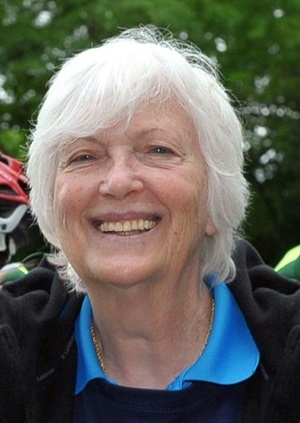Bunny Kasper connects the T1D community through baking… and her “WIG”

Each year, Bunny Kasper of Hamden, Connecticut, bakes at least a dozen different kinds of fudge, up to three varieties of a muddy-buddy trail mix affectionately called “bike crack,” and other tasty treats to revive weary bike riders participating in the JDRF Ride to Cure Diabetes.
Her culinary skills are legendary within the JDRF community and have garnered quite the following. Rightly so—she is a self-taught former professional cake baker and decorator whose work impressed none other than Julia Child.
But Kasper’s service to JDRF and support of the T1D community began well before she picked up her spatula to bake for the Rides 10 years ago.
“I was diagnosed with type 1 diabetes (T1D) in my 60s, but I’d never heard of JDRF because when I was  diagnosed, people still thought of type 1 as a disease that affects children,” Kasper said. “It wasn’t until years later when my grandson, Jake, was diagnosed and my son became involved with JDRF that I was suddenly finding myself going to walks for Jake and getting very involved in whatever my son and his family were doing with JDRF.”
diagnosed, people still thought of type 1 as a disease that affects children,” Kasper said. “It wasn’t until years later when my grandson, Jake, was diagnosed and my son became involved with JDRF that I was suddenly finding myself going to walks for Jake and getting very involved in whatever my son and his family were doing with JDRF.”
Kasper had been a long-time member of the board of directors of the Jewish Senior Services in Fairfield, Connecticut, where she had started a program of peer support that received national acclaim. When she started participating in JDRF activities for her grandson, JDRF leaders reached out right away.
“I got a phone call asking if I would like to be on the JDRF board to start similar programs for the diabetes community,” said Kasper, who has two grandsons—now young adults—who have been diagnosed with T1D. “I could never say no to JDRF about anything because of my grandchildren.”
Kasper became JDRF’s outreach chair and started a support group in New Haven for parents of T1D children. While the parents held meetings, the children had a playgroup. She also started a mentoring program and an annual walk team exclusively for newly diagnosed families.
But for Kasper, a particular point of pride is the support group she started for adults with T1D—a community, that she says, is desperate for connection.
“One of the folks in the group is a representative for a company that produces pumps,” Kasper said. “She came up to me and thanked me for starting this group. It allowed her to be part of a community where she wasn’t the one teaching about T1D or supporting others with T1D, but where instead, she could feel connected and get support for herself as an adult with T1D.”
Kasper jokes that helping adults with T1D—particularly senior citizens—is her “WIG” and she’s proud to say that she wears it daily.
“WIG being ‘wildly important goal,’” Kasper said, crediting the term to a speaker she once heard at a conference. “It’s so important to educate the community and get the word out to make sure that these people [adults and seniors with T1D]—who are a majority of the type 1s—understand the disease and are being cared for appropriately.”
“More people need to understand that this disease is not just a difficult disease to live with,” said Kasper. “But it’s difficult to get the right help for it so that you GET to live with it.”